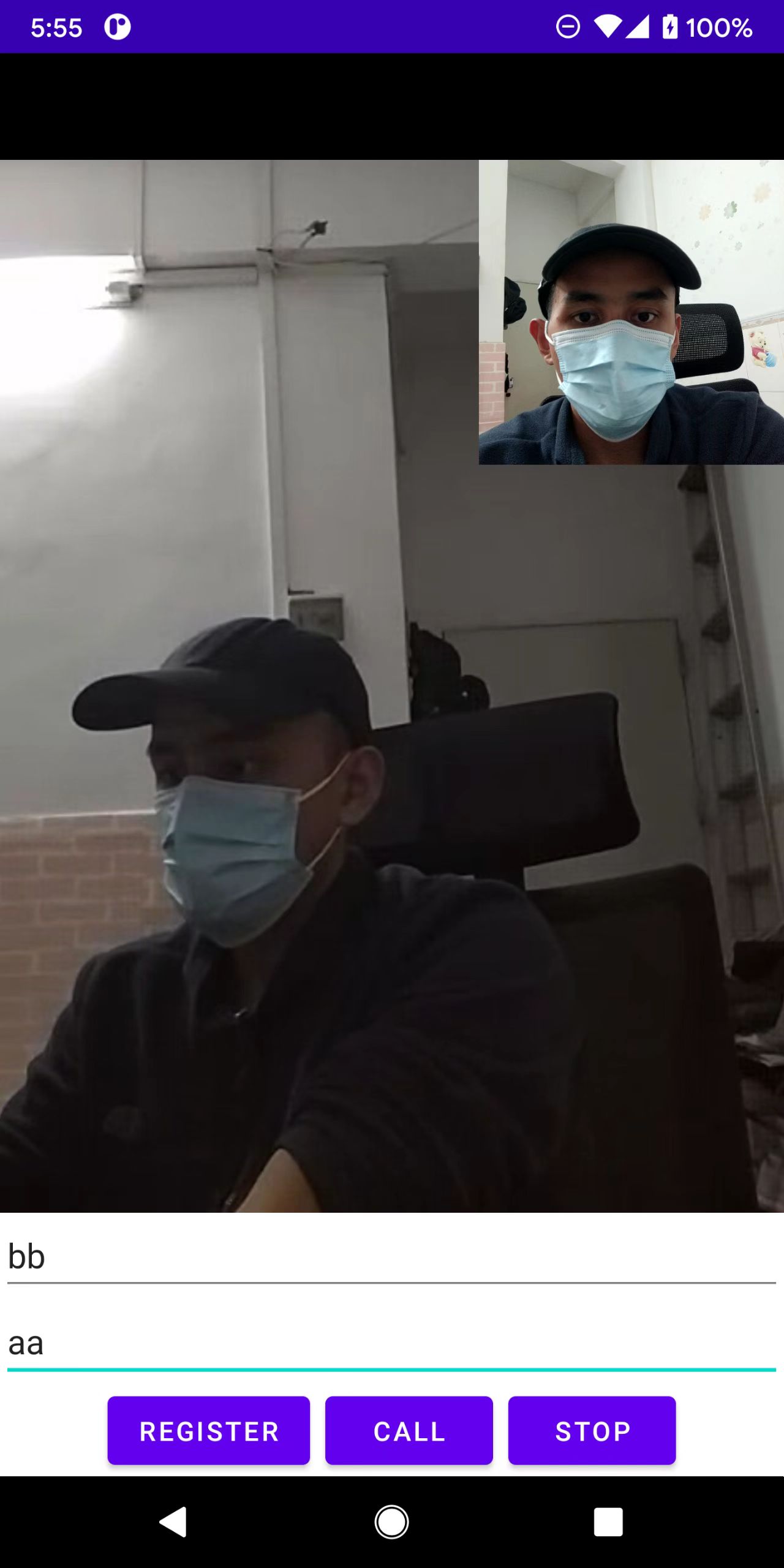webrtc对等连接
- ClientA注册,ClientB注册.
- ClientA创建SdpOffer,成功后调用setLocalDescription()设置为本地描述.
- ClientA发起Call,将SdpOffer发送给信令服务器.
- ClientB接收到请求(incomingCall),ClientB接受后配置本地媒体数据.
- ClientB创建SdpOffer,成功后调用setLocalDescription()设置为本地描述.
- ClientB发起incomingCallResponse,将sdpOffer发送给信令服务器.
- ClientB接收到startCommunication,调用setRemoteDescription将SdpAnswer设置为远程描述,ClientB已经获知连接双方的配置.
- ClientA接收到callResponse,调用setRemoteDescription将SdpAnswer设置为远程描述,ClientA已经获知连接双方的配置.
信令主要流程图

引入库
implementation 'org.webrtc:google-webrtc:1.0.32006'
implementation 'org.java-websocket:Java-WebSocket:1.5.3'
implementation "com.google.code.gson:gson:2.+"初始化PeerConnectionFactory
PeerConnectionFactory.initialize(
PeerConnectionFactory.InitializationOptions.builder(
this.applicationContext
)
.setFieldTrials("WebRTC-H264HighProfile/Enabled/")
.setEnableInternalTracer(true)
.createInitializationOptions()
)创建PeerConnecitonFactory
val encoderFactory = DefaultVideoEncoderFactory(bglBase.eglBaseContext, true, true)
val decoderFactory = DefaultVideoDecoderFactory(bglBase.eglBaseContext)
peerConnectionFactory = PeerConnectionFactory.builder()
.setVideoEncoderFactory(encoderFactory)
.setVideoDecoderFactory(decoderFactory)
.createPeerConnectionFactory()创建PeerConnection
val peerConnectionFactory = createPeerConnectionFactory()
// 配置STUN穿透服务器 转发服务器
val iceServers = ArrayList<PeerConnection.IceServer>()
val iceServer: PeerConnection.IceServer =
PeerConnection.IceServer.builder(Config.STUN).createIceServer()
iceServers.add(iceServer)
// streamList = ArrayList()
val configuration = PeerConnection.RTCConfiguration(iceServers)
peerConnection = peerConnectionFactory.createPeerConnection(configuration, this)
}在Observer.onIceCandidate响应时,将信息发送给服务端
override fun onIceCandidate(iceCandidate: IceCandidate?) {
//发送IceCandidate
sendIceCandidate(iceCandidate)
}在OnMessage接收到iceCandidate添加到peerConnection
peerConnection.addIceCandidate(iceCandidate)初始化WebSocketClient
val webSocketClient=object :WebSocketClient(URI.create(Config.URL)){
override fun onOpen(handshakedata: ServerHandshake?) {
Log.i(TAG, "WebSocket连接成功")
}
override fun onMessage(message: String?) {
Log.e(
TAG, "######## onMessage ########\n$message"
)
val jsonObject = Gson().fromJson(message, JsonObject::class.java)
when (jsonObject["id"].asString) {
REGISTER_RESPONSE -> {
// 注册回应
}
INCOMING_CALL -> {
//来电
}
CALL_RESPONSE -> {
//呼叫回应
}
START_COMMUNICATION -> {
//开始通迅
}
STOP_COMMUNICATION->{
//停止通迅
}
ICE_CANDIDATE -> {
//接收到IceCandidate后调用addIceCandidate
}
}
}
override fun onClose(code: Int, reason: String?, remote: Boolean) {
Log.i(TAG, "onClose code=$code reason=$reason remote=$remote")
}
override fun onError(ex: Exception?) {
ex?.printStackTrace()
}
}通过PeerConnectionFactory创建数据源VideoTrack/AudioTrack
准备摄像头,是否有前置摄像头,如果有就用前置摄像头:
private fun createCameraCapturer(enumerator: CameraEnumerator): VideoCapturer? {
val deviceNames = enumerator.deviceNames
// First, try to find front facing camera
Log.d(TAG, "Looking for front facing cameras.")
for (deviceName in deviceNames) {
if (enumerator.isFrontFacing(deviceName)) {
Logging.d(TAG, "Creating front facing camera capturer.")
val videoCapturer: VideoCapturer? = enumerator.createCapturer(deviceName, null)
if (videoCapturer != null) {
return videoCapturer
}
}
}
// Front facing camera not found, try something else
Log.d(TAG, "Looking for other cameras.")
for (deviceName in deviceNames) {
if (!enumerator.isFrontFacing(deviceName)) {
Logging.d(TAG, "Creating other camera capturer.")
val videoCapturer: VideoCapturer? = enumerator.createCapturer(deviceName, null)
if (videoCapturer != null) {
return videoCapturer
}
}
}
return null
}在Android系统下有两种Camera,一种称为 Camera1,是一种比较老的采集视频数据的方式,别一种称为Camera2,是一种新的采集视频的方法。它们之间的最大区别是Camera1使用同步方式调用API,Camera2使用异步方式,所以Camera2更高效。这里如果支持Camera2就使用Camera2, 如果不支持就使用Camera1。
private fun createVideoCapturer(): VideoCapturer {
return if (Camera2Enumerator.isSupported(this)) {
createCameraCapturer(Camera2Enumerator(this))!!
} else {
createCameraCapturer(Camera1Enumerator(true))!!
}
}配置视频数据源VideoTrack
val videoSource = peerConnectionFactory.createVideoSource(true)
val surfaceTextureHelper = SurfaceTextureHelper.create(
Thread.currentThread().name,
eglBase().eglBaseContext
)
val videoCapturer: VideoCapturer = createVideoCapturer()
//将videoCapturer与videoSource绑定在一起
videoCapturer.initialize(
surfaceTextureHelper,
this.applicationContext,
videoSource.capturerObserver
)
//调用startCapture打开摄像头
videoCapturer.startCapture(
Config.VIDEO_RESOLUTION_WIDTH,
Config.VIDEO_RESOLUTION_HEIGHT,
Config.VIDEO_FPS
)
val videoTrack = peerConnectionFactory.createVideoTrack(Config.VIDEO_TRACK_ID, videoSource)
videoTrack.setEnabled(true)
videoTrack.addSink(localSurfaceView)
配置音频数据源AudioTrack
val audioConstraints = MediaConstraints()
//回声消除
audioConstraints.mandatory.add(
MediaConstraints.KeyValuePair(
"googEchoCancellation",
"true"
)
)
//自动增益
audioConstraints.mandatory.add(MediaConstraints.KeyValuePair("googAutoGainControl", "true"))
//高音过滤
audioConstraints.mandatory.add(MediaConstraints.KeyValuePair("googHighpassFilter", "true"))
//噪音处理
audioConstraints.mandatory.add(
MediaConstraints.KeyValuePair(
"googNoiseSuppression",
"true"
)
)
val audioSource = peerConnectionFactory.createAudioSource(audioConstraints)
val audioTrack = peerConnectionFactory.createAudioTrack(Config.AUDIO_TRACK_ID, audioSource)
添加音视频到MediaStream
val medisStream = peerConnectionFactory.createLocalMediaStream("local_stream")
medisStream.addTrack(audioTrack)
medisStream.addTrack(videoTrack)同样在onAddTrack添加远程视频流即可,以下是两个手机的测试:





评论